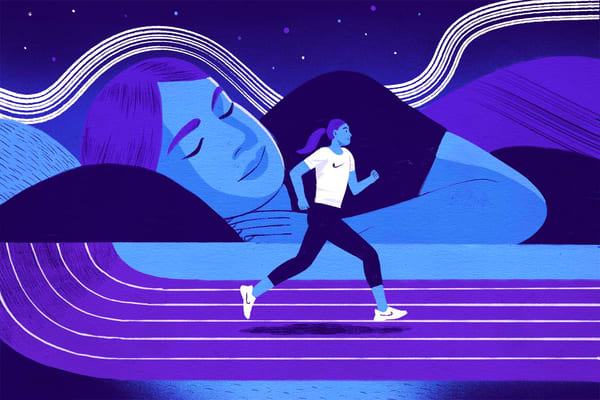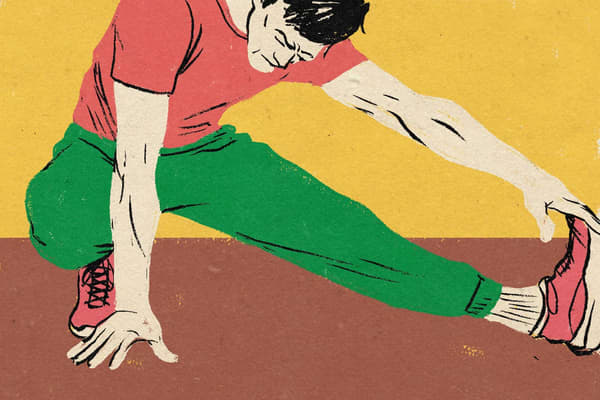5 Yoga Moves to Help You Sleep Better
Health & Wellness
Sleep experts share a handful of yoga poses that could help you snooze a bit easier.

If it's challenging to get your mind to settle down before bed, you might benefit from spending a few minutes on the yoga mat before your head hits the pillow.
Many people across the globe struggle to get adequate sleep—and for a variety of different reasons. According to 2021 data from the American Sleep Association, between 50 and 70 million US adults have a sleep disorder. Furthermore, 70 percent of adults around the world are now facing at least one new sleep challenge since the start of the pandemic, reported Philips 2021 Global Sleep Survey (which polled adults in 13 countries, including Brazil, France and Italy).
Insomnia, or the difficulty of falling asleep and staying asleep, tops the list as the most common sleep condition. In fact, 30 percent of US adults deal with short-term insomnia and 10 percent suffer from chronic insomnia.
The Center for Disease Control and Prevention reports that adults generally need seven or more hours of sleep each night for overall health and well-being. However, more than 35 percent of US adults report sleeping fewer than seven hours during a typical 24-hour period, per the Sleep Foundation.
How Can Yoga Help Improve Sleep?
There are several ways you can prepare your mind and body for a good rest, including avoiding caffeine at least six hours before bedtime—as well as powering down your phone, tablet or TV before hitting the sheets. However, one of the most effective methods may be doing a handful of calming yoga poses.
"It's important to set the stage for sleep and having a regular relaxation practice before bedtime allows sleep to naturally unfold more easily", said Sarah Silverman, Psy D, a behavioural sleep medicine specialist and holistic sleep wellness consultant. "Using gentle stretching or movement to relax can become an internal cue for the mind and body that sleep is going to happen soon".
(Related: 5 Simple Ways To Create a Relaxing At-home Yoga Space)
Practising yoga before bed can also benefit folks who suffer from restless sleep, too. A systematic review of 19 studies and meta-analysis published in a 2020 issue of the journal BMC Psychiatry suggested yoga may help improve sleep quality among females who have sleep problems, especially compared to those who don't do yoga before bed.
Physical tension, along with an over-active mind and racing thoughts, can stimulate our sympathetic nervous system (aka flight or flight) and keep us from falling—and staying—asleep, said Mark Stephens, certified yoga therapist and member of the International Association of Yoga Therapists.
"However, a calming yoga practice can help [you] go the other way, in turn, stimulating our parasympathetic nervous system, [also known as] rest and digest, to induce sleep and help [you] stay asleep for a healthy seven to nine hours", he said.
Yoga Poses for Better Sleep
The main goal here is to pay attention to your breath work. "Focusing more on slowing down your breathing can help the mind and body unwind, and thus facilitate sleep", Silverman said.
Stephens recommended following this 30-minute sleep sequence before bedtime. Start by spending a few minutes sitting and breathing lightly and consciously. Then, transition to longer exhalations than inhalations for another few minutes.
"This is called Visama Vritti Pranayama, which can be very calming. Maintain this breathing pattern when doing the following postures", he said.
1.Peaceful Resting Pose (about 2–3 minutes)
Lay on one side with arms on either side of your upper body, bend the knee on the leg that is under your body and extend it slightly forwards at a 90 degree angle. Then with the leg on top, move the bottom half of your leg (from the knee down) backwards also at a 90 degree angle.
"This asymmetrical pose helps to reduce tension throughout the body by lightly stretching the hips, legs and torso", Stephens said. "With the chest fully supported on a bolster, one can completely relax and let go of accumulated tension from the day".
2.Child's Pose (about 5 minutes)
Start by getting onto your knees. Then, slowly sink your pelvis down until it meets the heels of your feet. The tops of your feet should lay flat on the mat and the toes from each foot should touch. Spread your knees slightly apart with the toes still together. Bow forwards with your head until it touches the mat while your chest rests either between or on top of your thighs. Then, gently move your arms back next to your thighs with the palms facing up and the elbows relaxed.
"This symmetrical pose is done with the knees wide apart and chest fully supported, [which] further releases tension in the legs and hips while letting the spine completely relax", Stephens said.
3.Seated Forward Bend (about 2–3 minutes)
Sit on the mat with your legs extended straight out in front of you. Feet should be touching. Gently bend forwards and extend your arms as far down as you can (whether it's to your knees, calves or toes).
"This pose flexes the spine, stimulating the parasympathetic nervous system", Stephens said.
4.Legs Up the Wall Pose (about 5–10 minutes)
Lie flat on your back with your glutes close to (about a few centimetres) a wall with your upper body perpendicular to the wall. Your legs should be bent and propped up on the wall. Extend both arms along the sides of your body, with the palms facing up. Then, pull your legs up onto the wall, extend them and hold.
"This simple inversion both drains lymph from the feet and legs and slows the heart rate", Stephens said, "[and] it is the number one most calming yoga pose".
For context, the lymphatic system helps maintain fluid levels and filter waste from the body, so draining lymph can help boost body fluid balance and increase immunity.
5.Mindful Breathing Meditation (about 5 minutes)
Sit in a comfortable position. Allow your mind to rest while taking deep breaths with long exhalations, Stephens said.
"You can also silently say to yourself the words 'inhale' and 'exhale' as the breath flows in and out", he added.
Proper Techniques for Bedtime Yoga
If you're going to practise this ancient practice before bedtime, Silverman suggested doing the movements about two hours before climbing into bed.
"Everyone is different, so you may have to play around with timing", she said. "Strenuous movement can raise your core body temperature. Yet, your temperature needs to drop a few degrees before bedtime in order to transition to sleep".
She also advised dimming the lights or lighting a candle since limiting exposure to bright light before bedtime can help maintain your natural sleep cycle. Light has been shown to have a direct effect on circadian rhythms, which controls the sleep/wake cycle, according to the National Sleep Foundation. Stephens agreed that your environment plays a vital role in sleep hygiene. "It's important to create a sleep paradise: cool, cosy, dark and quiet", he said.
The length of your practice isn't as important as the movements you do, Silverman suggested. "Listen to what your body needs and what feels good for you to promote relaxation and reduce tension", she said.
Bear in mind that doing yoga earlier in the day can also encourage your body to sleep well throughout the night. Research published in a 2014 issue of journal Alternatives Therapies in Health and Medicine found that older males and females (ages 60 and older) with insomnia—who practised yoga twice a week for 12 weeks—reported significant improvements in their sleep patterns and overall health. More specifically, participants experienced notable, positive changes in their overall sleep quality, sleep efficiency, length of sleep, as well as vitality, emotional state and well-being.
Stephens said the key to using yoga for better sleep is to practise it on a routine basis, which could be a few days a week or maybe a little bit every day. It largely depends on what you have time for.
"Many people benefit from a vigorous and stimulating practice earlier in the day, helping them to have more balanced energy throughout the day and night", he said.
Words by Amy Capetta





